

Snapchat and Vines in Classrooms - The Highlighter. Edudemic: 10 Real-World Ways Schools Are Using Social Media - Expio: Social. (happily shared) from edudemic.com Two big milestones were hit recently.
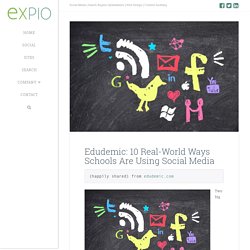
First, the population of Earth hit 7 billion, more than double what it was fifty years ago. Second, the population on Facebook hit a billion users, meaning that roughly one in every six humans has a Facebook account, something that wasn’t remotely possible fifty years ago. Every Classroom Matters on BAM! Radio Network. Learning and Sharing with Ms. Lirenman: Social Media In Grade One? You Betcha! In July of 2011, I joined twitter and since then my teaching world has exploded.
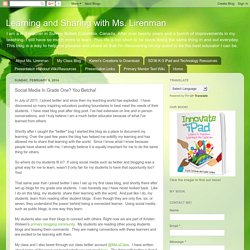
I have discovered so many inspiring educators pushing boundaries to best meet the needs of their students. I have read blog post after blog post. Skype in the classroom - Google Slides. Global Collaboration Projects that Go Way Beyond Skype. Collaboration & Social Networking | Feature Page 2 of 3 Global Collaboration Projects that Go Way Beyond Skype Teachers, too, can benefit from global outreach tailored to their needs.

Trinity Valley School: Virtual Exchanges. Connecting with others through the Internet Essential to a TVS Global Education are multinational online learning exchanges.
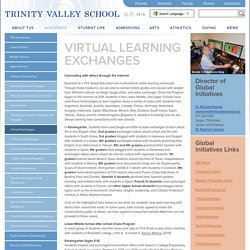
Through these mediums, we are able to connect entire grades and classes with people from different cultures via blogs, Skype chats, and video exchanges. Teacher Spotlight: Ann Oro, Saint Michael School. Tagged with: Ann Orocomputer technologyEdmodo Spotlightelementary schoolMiddle Schoolteacher spotlight This post is part of our Edmodo Spotlight series which highlights Edmodo teachers, schools and districts.
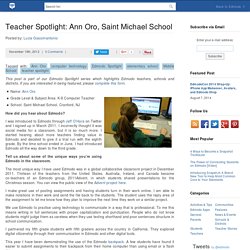
If you are interested in being featured, please complete this form. Start with a Question: Guest Post: A Guide to Using Instagram in the Classroom. By Jennifer Gray Everyone loves social media.
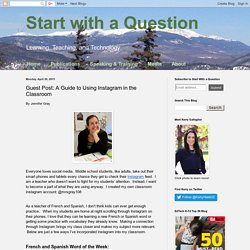
Middle school students, like adults, take out their smart phones and tablets every chance they get to check their Instagram feed. I am a teacher who doesn’t want to fight for my students’ attention. Instead, I want to become a part of what they are using anyway. I created my own classroom Instagram account: @mrsgray108 As a teacher of French and Spanish, I don’t think kids can ever get enough practice. French and Spanish Word of the Week: Top Dog Teaching : Three Reasons Students Should Own Your Classroom's Twitter and Instagram Accounts. This work is my column that was originally posted on Edsurge.com.

It is quickly becoming a non-negotiable for all classrooms to leverage social media in order to communicate with families and other classrooms—thus engaging others in the daily lives of students. While simply posting “fun” photos is a start, this novelty wears off quickly, and as a result, we must think more critically about how we communicate via social media. How I use Facebook in my Kindergarten classroom. Last year, Kindergarten teacher Bethene Songer from Western Hills Elementary approached her building principal with the idea of using Facebook to engage her parents.
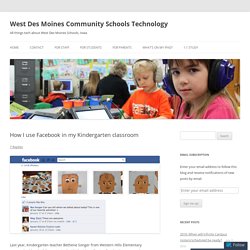
After discussions with School Community Relations and technology department, they set out to pilot the use of Facebook to engage parents. The following questions and answers are provided by the team involved in the pilot, which included: Bethene Songer, Kindergarten teacher at WH; Beth Thornton, principal at WH, Brian Abeling from Technology. Q1. Why Facebook? Why not just a regular web page? Q2.
Q3. Q4. Q5. Today… Facebook is allowed in class. Usually in a classroom teachers would tell their students to stay off Facebook but today Morah Gail has come up with somewhat of an unconventional assignment.
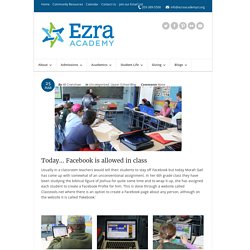
In her 6th grade class they have been studying the biblical figure of Joshua for quite some time and to wrap it up, she has assigned each student to create a Facebook Profile for him. This is done through a website called Classtools.net where there is an option to create a Facebook page about any person, although on the website it is called ‘Fakebook.’ 8 Real Ways Facebook Enriched Ms. Schoening’s First Grade Class. Bringing Twitter to the Classroom. Highlighting vocabulary words; underlining passages; drawing stars and smiley faces in the margins—these are the hallmarks of ninth grade English class.
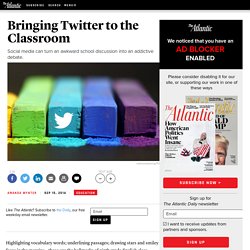
Students are encouraged to interact with the text, almost holding a conversation with it, so they can be prepared to comment and discuss. Yet when the teacher prompts her class—“Does anyone have something interesting to share about the reading from last night?” —she is greeted with silence, broken only by light whispers of book pages. Most of us remember these uncomfortable moments the same way we remember the awkward haircuts and wardrobes that accompanied them.
But now, picture a computer screen covered in hashtags and “at” signs—#shakespeare and @3rdperiodenglish. School-Wide Twitter Chats. Have you ever had a student say to you, "Wow, this is so much fun, do we have to stop? " This is the kind of excitement that children have shared with teachers after participating in the New Zealand school-wide Twitter chat called Kidsedchatnz. The Kidsedchatnz idea was born out of numerous worldwide Twitter chats for educators. If educators could use Twitter to connect, collaborate, share, and learn, then why couldn't students?